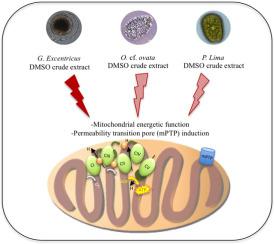Comparative Biochemistry and Physiology C: Toxicology & Pharmacology ( IF 3.9 ) Pub Date : 2020-11-07 , DOI: 10.1016/j.cbpc.2020.108937 Ana T Varela 1 , Raquel A F Neves 2 , Silvia M Nascimento 3 , Paulo J Oliveira 4 , Miguel A Pardal 1 , Elsa T Rodrigues 1 , António J Moreno 5

|
Even though marine dinoflagellates are important primary producers, many toxic species may alter the natural equilibrium of aquatic ecosystems and even generate human intoxication incidents, as they are the major causative agents of harmful algal blooms. In order to deepen the knowledge regarding benthic dinoflagellate adverse effects, the present study aims to clarify the influence of Gambierdiscus excentricus strain UNR-08, Ostreopsis cf. ovata strain UNR-03 and Prorocentrum lima strain UNR-01 crude extracts on rat mitochondrial energetic function and permeability transition pore (mPTP) induction. Our results, expressed in number of dinoflagellate cell toxic compounds tested in a milligram of mitochondrial protein, revealed that 934 cells mg prot−1 of G. excentricus, and 7143 cells mg prot−1 of both O. cf. ovata and P. lima negatively affect mitochondrial function, including by decreasing ATP synthesis-related membrane potential variations. Moreover, considerably much lower concentrations of dinoflagellate extracts (117 cells mg prot−1 of G. excentricus, 1429 cells mg prot−1 of O. cf. ovata and 714 cells mg prot−1 of P. lima) produced mPTP-induced swelling in Ca2+-loaded isolated mitochondria. The present study clearly demonstrates the toxicity of G. excentricus, O. cf. ovata and P. lima extracts at the mitochondrial level, which may lead to mitochondrial failure and consequent cell toxicity, and that G. excentricus always provide much more severe effects than O. cf. ovata and P. lima.
中文翻译:

接触海洋底栖甲藻毒素可能导致线粒体功能障碍
尽管海洋甲藻是重要的初级生产者,但许多有毒物种可能会改变水生生态系统的自然平衡,甚至引发人类中毒事件,因为它们是有害藻华的主要致病因素。为了加深对底栖甲藻不利影响的认识,本研究旨在阐明Gambierdiscus excentricus菌株 UNR-08、 Ostreopsis cf. 的影响。 ovata菌株UNR-03和Prorocentrum lima菌株UNR-01粗提物对大鼠线粒体能量功能和通透性转换孔(mPTP)的诱导。我们的结果以一毫克线粒体蛋白中测试的甲藻细胞毒性化合物的数量表示,显示G. excentricus的 934 个细胞 mg prot -1 ,以及两种O. cf. 的 7143 个细胞 mg prot -1 。 ovata和P. lima对线粒体功能产生负面影响,包括减少 ATP 合成相关的膜电位变化。此外,显着低浓度的甲藻提取物( G. excentricus 117 cells mg prot -1 、 O. cf. ovata 1429 cells mg prot -1和P. lima 714 cells mg prot -1 )产生 mPTP 诱导的肿胀在Ca 2+负载的分离线粒体中。本研究清楚地证明了G. excentricus , O. cf. 的毒性。 ovata和P. lima在线粒体水平上提取,这可能导致线粒体衰竭和随之而来的细胞毒性,并且G. excentricus 总是提供比O. cf. 更严重的影响。卵形和利马。











































 京公网安备 11010802027423号
京公网安备 11010802027423号